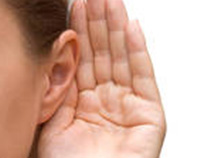
Auditory Acuity
How well and sharp you hear is important for safe driving. Your hearing can:
- Warn you of danger such as the presence of vehicles in your blind spots
- Allow you to respond to:
- Someone honking their horn
- Emergency vehicle sirens
- Bells at railroad crossings
- Alert you to impending engine or other mechanical failure.
Partial Deafness
A hearing impairment that causes the inability to hear low to medium (softer) decibel sounds or sounds of certain frequencies.
Total Deafness
A hearing impairment that results in the inability of the person to hear, even the loudest of sounds. The person hears NO sound at all.
Compensation for Hearing Impairment
- A person can compensate for a hearing impairment and improve his or her ability to drive safely by seeing a doctor and having a hearing aid fitted to amplify sounds.
- A person with a hearing impairment or total deafness can also compensate by learning to rely more on vision, such as increasing the degree to which they visually scan their environment.
Hearing Care
Auditory acuity deteriorates with age. It is important to have your hearing checked periodically by a doctor because often changes in hearing occur so slowly that people do not notice them.
Considerations for Hearing and Driving
- To hear properly while driving a vehicle you should:
- Keep the volume of your vehicle’s audio system low
- Keep at least one window open so you can better hear outside noises
- A person must not wear a headset or earplugs that cover both ears while driving.
Brief History About Hearing Aid
 A hearing aid is a device used to help hard-of-hearing people hear sounds better. One of the first hearing aids, the Metal Ear,
A hearing aid is a device used to help hard-of-hearing people hear sounds better. One of the first hearing aids, the Metal Ear, was created in the 17th century and was made to be put over ears. The hearing aids created in the beginning of the 19th century were bulky devices that would sit on tables. Later, in the 19th century, ear trumpets and cones were used as hearing aids. The first full-scale manufacturer of hearing aids was Frederick Rein of London in 1800. He produced ear trumpets, hearing fans and conversation tubes. These instruments helped amplify sounds while still being portable. There was one major flaw to early hearing aids. This flaw was that the longer or wider the instrument, the greater the sound. So in order for these instruments to be portable, it had to be downsized, which caused it to not be as beneficial to the individual. Finally in the late 1800s, the acoustic horn, which was a tube that had two ends and a cone that captured sound, was eventually made to fit in the ear. Toward the late 19th century, individuals pushed for the idea of hidden hearing aids.
was created in the 17th century and was made to be put over ears. The hearing aids created in the beginning of the 19th century were bulky devices that would sit on tables. Later, in the 19th century, ear trumpets and cones were used as hearing aids. The first full-scale manufacturer of hearing aids was Frederick Rein of London in 1800. He produced ear trumpets, hearing fans and conversation tubes. These instruments helped amplify sounds while still being portable. There was one major flaw to early hearing aids. This flaw was that the longer or wider the instrument, the greater the sound. So in order for these instruments to be portable, it had to be downsized, which caused it to not be as beneficial to the individual. Finally in the late 1800s, the acoustic horn, which was a tube that had two ends and a cone that captured sound, was eventually made to fit in the ear. Toward the late 19th century, individuals pushed for the idea of hidden hearing aids.
This push caused for a change in hearing aids to be more invisible. As a result, hearing aids would be hidden in couches, clothing and  accessories. The invisibility of the hearing aid also hurt the hearing of the individual, because there was more worry for society to find out that the individual had a disability, than helping out the individual. It was not until the development of miniaturization that hearing aids became more focused on helping individuals with disabilities and not hiding the disability. The 20th century marked the moment where hearing aids shifted from mechanical to electrical designs with the help of advanced technology.
accessories. The invisibility of the hearing aid also hurt the hearing of the individual, because there was more worry for society to find out that the individual had a disability, than helping out the individual. It was not until the development of miniaturization that hearing aids became more focused on helping individuals with disabilities and not hiding the disability. The 20th century marked the moment where hearing aids shifted from mechanical to electrical designs with the help of advanced technology.

